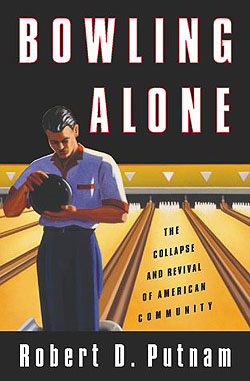
Office: HGH 210; phone: (408) 924-5378
Email: wooda@email.sjsu.edu
Web: http://www.sjsu.edu/faculty/wooda

|
Dr. Andrew Wood Office: HGH 210; phone: (408) 924-5378 Email: wooda@email.sjsu.edu Web: http://www.sjsu.edu/faculty/wooda |
 Cover - Bowling Alone: The collapse and revival of American community |
In his article, "Bowling Alone" - the genesis for a recently published book, Bowling Alone: The collapse and revival of American community - Robert Putnam offers an important thesis about public life in America: "There is striking evidence . . . that the vibrancy of American civil society has notably declined over the past several decades" (p. 65). To Putnam, this trend is important because a decline in civic engagement leads to diminished vibrancy of representative government. The key term employed by Putnam to measure this vibrancy is social capital, "features of social organization such as networks, norms, and social trust that facilitate coordination and cooperation for mutual benefit" (p. 67). Certainly, some critics of Putnam's thesis suggest that too much social capital, or social capital without concern for certain values, can be dangerous. Consider the 1998 film Pleasantville as merely one example. however, according to Putnam, a solid stock of social capital leads to at least three benefits:
In his article, Putnam measures various declines in social capital. As you might expect, he begins with the well-known decrease in voter participation and trust in government. Putnam asks whether historical events such as Watergate and the Vietnam conflict may, themselves, explain declines in civic engagement. He responds that they might if only political indicators of social capital fell. But American public life has declined in more ways than that. Studying a wide range of surveys about civic engagement, including participation in organized religion, parent-teacher associations, fraternal groups, and other civic organizations, Putnam concludes that participation in traditional civic groups has declined in the United States across the board. |
 Putnam notes that America continues to be a religious society, but "religious sentiment in American seems to be becoming somewhat less tied to institutions and more self-defined" (1995, p. 69). |
Putnam notes two major counter-trends that may challenge his thesis but argues that they are ultimately unable to reverse civic decline. Turning to the first trend, one may argue that "membership in civic organizations . . . is not so much dropping as shifting from established groups to new ones" that are looser and more flexible than traditional organizations (Miller, 1999, n.p.). Indeed, new mass-membership organizations such as the Sierra Club or non-profit service agencies like Oxfam might fill the gap in traditional public engagement. Putnam responds that despite common symbols, leaders, and ideals, these largely impersonal organizations cannot replace the interaction found in a bowling league or gardening club. A second major counter-trend (the third in Putnam's list) suggests that support groups fill the void left in the wake of diminished participation in traditional civic groups. Putnam responds that support groups fail in this regard because they tend to focus on personal needs more than they facilitate engagement in public life. Dispatching these potential critiques, Putnam suggests that a decline in individual investment in community-building organizations might explain a decreasing sense of trust among Americans.
But what can explain the decline in civic participation among Americans? The four reasons Putnam provides are insightful to varying degrees. He first notes that the movement of women into the [paid] labor force might account for the decrease in social capital. Certainly, activity in traditional "women's organizations" has decreased since more women have left the domestic sphere. But Putnam concludes that other trends are obscured by this single hypothesis. Perhaps the growing mobility of American families might explain the decline in civic engagement. Putnam largely rejects this notion, stating that home ownership and its corollary, stability, have largely risen since the mid 1960s. Perhaps other demographic transformations - the reduction in marriages, increase in divorces, and the declining number of children per family - have undermined civic engagement. These are compelling reasons, but they're so broad as to be conceptually difficult to manage. Putnam also explores the "technological transformation of leisure" through which "privatizing" and "individualizing" entertainment - epitomized by television and the emerging promise of virtual reality helmets - has eclipsed community-based entertainment like turn-of-the-century vaudeville and mid-century movies. Putnam concludes with a call for more research into the nature of our declining social capital and proposed ways to reverse this trend. Question for consideration Miller's response to Putnam's "Bowling Alone" article lists several other limitations to the "decline in social capital" thesis not addressed in this note - including issues of virtue, individual rights, and biological inherence. Do any one of these individually or together sufficiently refute Putnam's thesis? Please be prepared to share and explain your answer. |
References